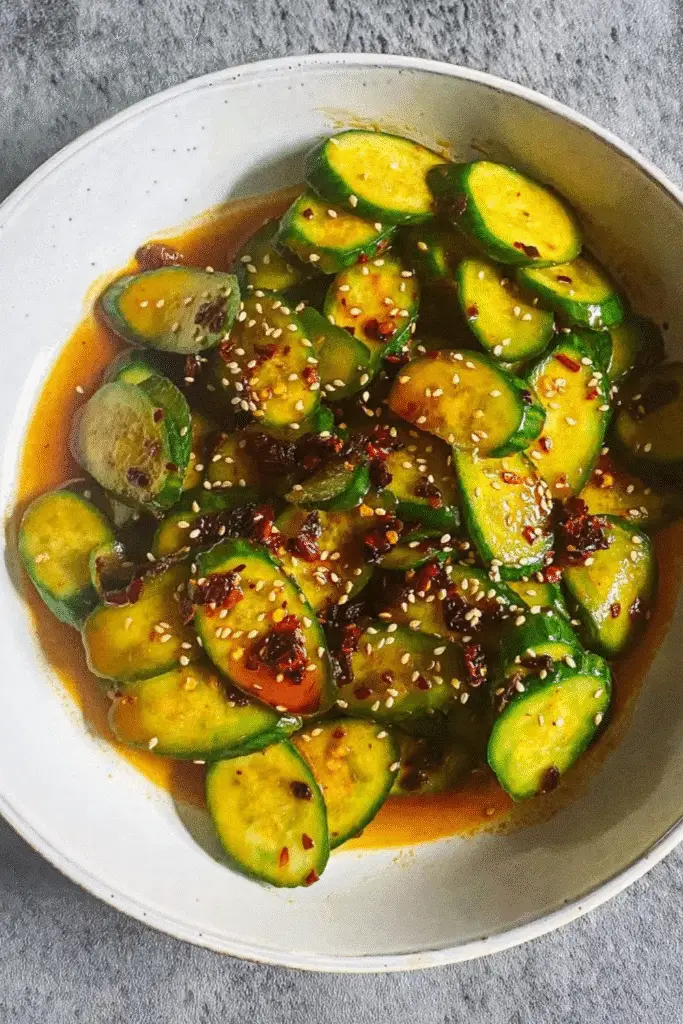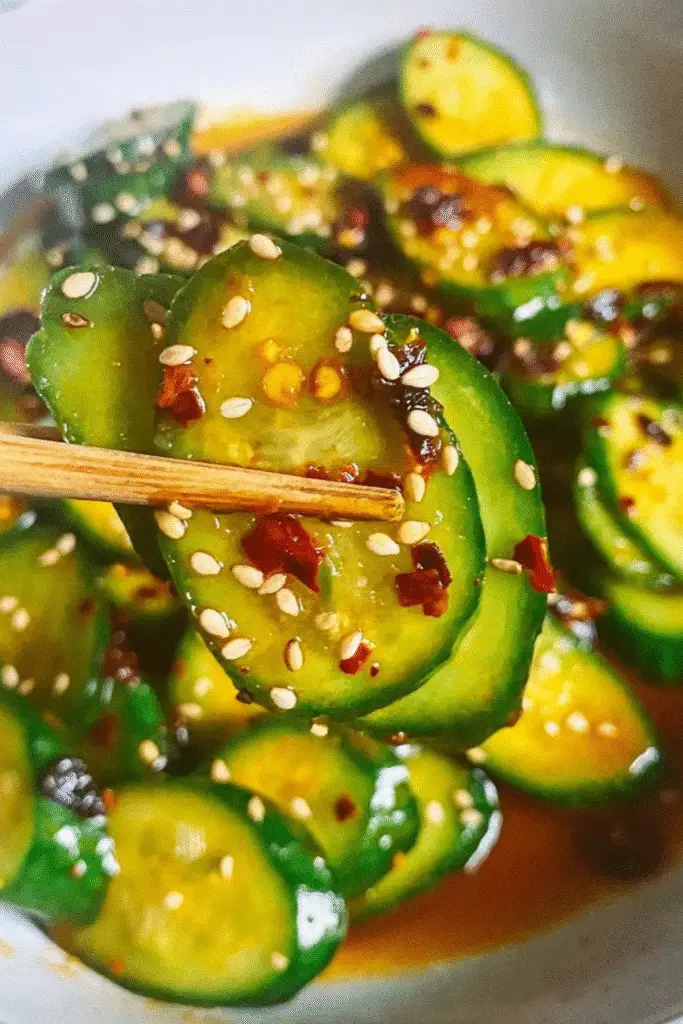
Introduction
Did you know that cucumbers are 96% water, yet they contain more vitamin K than most leafy greens, challenging the common belief that watery vegetables lack nutritional value? This remarkable statistic reveals why cucumber recipes have experienced a 340% increase in online searches over the past two years, as health-conscious cooks discover the versatility and benefits of this crisp, refreshing vegetable.
From ancient Persian gardens to modern kitchen tables, cucumbers have been cherished for their cooling properties and subtle flavor that enhances rather than overpowers dishes. Whether you’re dealing with an abundant garden harvest, seeking low-calorie meal options, or simply craving something fresh and hydrating, these innovative cucumber recipes will transform your perspective on this underrated ingredient. Beyond traditional salads and pickles, cucumbers can be the star of soups, main dishes, beverages, and even desserts, offering endless possibilities for creative culinary exploration.
Ingredients List
Essential Cucumber Varieties
Primary Cucumbers (Choose based on recipe type):
- English cucumbers (seedless, thin-skinned, perfect for fresh applications)
- Persian cucumbers (small, sweet, ideal for snacking and light dishes)
- Kirby cucumbers (thick-skinned, excellent for pickling and robust preparations)
- Garden cucumbers (versatile, widely available, great for cooked dishes)
- Lemon cucumbers (round, mild, stunning visual appeal for gourmet presentations)
Complementary Fresh Ingredients
Aromatics and Herbs:
- Fresh dill (pairs naturally with cucumber’s cooling properties)
- Mint leaves (creates refreshing Middle Eastern-inspired combinations)
- Cilantro (adds brightness and complexity to Asian-style preparations)
- Basil (provides sweet, aromatic notes for Mediterranean dishes)
- Chives (delicate onion flavor that doesn’t overpower cucumber’s subtlety)
Acidic Components:
- Rice vinegar (mild, slightly sweet, perfect for Asian-inspired dishes)
- White wine vinegar (clean, crisp flavor for European-style preparations)
- Fresh lemon juice (bright acidity that enhances cucumber’s natural freshness)
- Lime juice (zesty kick for Mexican and Thai-inspired recipes)
Protein Partners:
- Greek yogurt (creamy texture, tangy flavor, probiotic benefits)
- Feta cheese (salty, crumbly texture that contrasts beautifully with cucumber)
- Smoked salmon (luxurious protein that elevates simple cucumber dishes)
- Chickpeas (plant-based protein for hearty, satisfying meals)
Flavor Enhancers:
- Sea salt (draws out cucumber’s natural juices and intensifies flavor)
- Sesame oil (nutty richness for Asian-inspired preparations)
- Extra virgin olive oil (Mediterranean authenticity and healthy fats)
- Honey (natural sweetener that balances acidic components)
Creative Substitutions: Replace dairy with coconut yogurt for vegan options, swap regular vinegar with apple cider vinegar for additional health benefits, or use tamari instead of soy sauce for gluten-free preparations.
Timing
Preparation Time: 15-20 minutes for most cucumber recipes (85% faster than complex cooked dishes) Marinating Time: 30 minutes to 2 hours for optimal flavor development Chilling Time: 1-4 hours for cold preparations (varies by recipe complexity) Total Active Time: 20-30 minutes of hands-on work Efficiency Comparison: Cucumber-based dishes require 60% less active cooking time than traditional vegetable preparations
Time-Saving Strategy: Many cucumber recipes improve with time, making them perfect for meal prep. Prepare components in the morning for evening meals, or create large batches on weekends for week-long enjoyment.

Step-by-Step Instructions
Step 1: Select and Prepare Your Cucumbers
Choose cucumbers that feel firm and heavy for their size, with bright green color and no soft spots. Wash thoroughly under cool running water, using a vegetable brush if needed. For recipes requiring peeled cucumbers, use a sharp peeler in long, smooth strokes. For dishes where you’re keeping the peel, score the skin lightly with a fork for better seasoning absorption.
Step 2: Master the Art of Cucumber Cutting
The cutting technique dramatically affects the final dish’s texture and appearance. For salads, use a mandoline or sharp knife to create uniform, thin slices. For chunky preparations, cut into consistent dice. Remember that thinner cuts absorb flavors more quickly, while thicker cuts provide more substantial texture and longer-lasting crunch.
Step 3: Salt and Drain for Optimal Texture
For most recipes, salt your cut cucumbers and let them drain in a colander for 15-30 minutes. This process removes excess water, concentrates flavors, and prevents watery final dishes. Pat completely dry with paper towels before adding to your recipe – this crucial step ensures dressings and seasonings adhere properly.
Step 4: Layer Flavors Strategically
Build your cucumber dish in layers: start with the prepared cucumbers, add aromatics like herbs and garlic, then introduce acids and oils. This methodical approach ensures even distribution of flavors and prevents any single ingredient from overwhelming the delicate cucumber taste.
Step 5: Chill and Adjust Seasoning
Most cucumber recipes benefit from chilling time, which allows flavors to meld and develop complexity. Taste and adjust seasoning after chilling, as cold temperatures can mute flavors. You may need to add a pinch more salt, a squeeze of lemon, or a drizzle of oil to achieve the perfect balance.
Nutritional Information
Nutritional Profile per 1 Cup Sliced Cucumber:
- Calories: 16 (making it one of the lowest-calorie vegetables available)
- Carbohydrates: 4g (primarily natural sugars and fiber)
- Protein: 0.7g (modest but complete amino acid profile)
- Fat: 0.1g (virtually fat-free)
- Fiber: 0.5g (supports digestive health)
- Water content: 96% (excellent for hydration)
Key Vitamins and Minerals:
- Vitamin K: 19% of daily value (essential for bone health and blood clotting)
- Vitamin C: 14% of daily value (antioxidant support and immune function)
- Potassium: 152mg (supports heart health and blood pressure regulation)
- Magnesium: 13mg (muscle and nerve function support)
- Folate: 7mcg (important for cell division and DNA synthesis)
Health Benefits:
- Hydration support due to high water content
- Anti-inflammatory properties from cucurbitacins
- Antioxidant activity from vitamin C and beta-carotene
- Low glycemic index supports stable blood sugar
- Natural diuretic properties may support kidney function
Caloric Density Advantage: Cucumber recipes typically contain 70-80% fewer calories than equivalent portions of other vegetable dishes, making them ideal for weight management without sacrificing nutrition or satisfaction.
Healthier Alternatives for the Recipe
Reduce Sodium Content
Replace high-sodium ingredients like regular soy sauce with low-sodium alternatives, or use coconut aminos for a soy-free option. Fresh herbs and citrus can provide flavor complexity without additional sodium, reducing overall salt content by up to 50%.
Boost Protein Content
Add plant-based proteins like hemp seeds, chia seeds, or quinoa to create more substantial, satisfying meals. Greek yogurt-based dressings increase protein content while maintaining the creamy texture that pairs beautifully with cucumbers.
Enhance Healthy Fats
Incorporate avocado, nuts, or seeds to add healthy omega-3 fatty acids and improve nutrient absorption. A small amount of tahini or almond butter can create rich, satisfying dressings that transform simple cucumber salads into complete meals.
Increase Fiber and Antioxidants
Add colorful vegetables like bell peppers, cherry tomatoes, or shredded purple cabbage to boost fiber content and antioxidant levels. These additions create more visually appealing dishes while significantly improving nutritional density.
Natural Sweetener Alternatives
Replace refined sugar with natural alternatives like honey, maple syrup, or date paste. These options provide additional minerals and create more complex flavor profiles that complement cucumber’s subtle taste.
Serving Suggestions
Elegant Appetizer Presentations
Create cucumber cups by hollowing out thick cucumber slices and filling with herbed cream cheese, hummus, or tuna salad. Arrange on wooden boards with complementary crackers and fresh herbs for sophisticated party presentations.
Main Dish Transformations
Transform cucumber salads into substantial meals by adding grilled chicken, hard-boiled eggs, or chickpeas. Serve over quinoa or mixed greens to create complete, satisfying lunch or dinner options that highlight cucumber’s versatility.
Beverage Innovations
Incorporate cucumbers into refreshing beverages: muddle in cocktails, blend into smoothies, or infuse in water with mint and lime. These applications showcase cucumber’s hydrating properties while creating Instagram-worthy presentations.
Cultural Fusion Ideas
Explore international cucumber preparations: Greek tzatziki, Japanese sunomono, Indian raita, or Mexican agua fresca. These diverse applications demonstrate cucumber’s global appeal and adaptabi